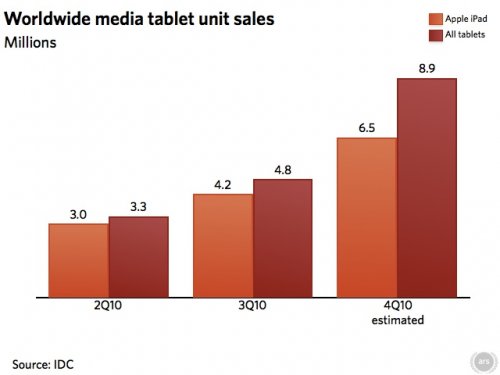We have talked about the so-called ‘Tablet Market’ as really being the ‘iPad Market’, with some marginal players scraping for scraps. Some of us have bought or spent considerable time with one or more of the various tablets that have come out over the last year – the Samsung Galaxy Tab, Motorola Xoom, BlackBerry Playbook, HP TouchPad, HTC Flyer, Acer Iconia, and on and on. Yet in all of these cases there have been some serious flaws that have derailed the tablets and ultimately resulted in the failure of the tablets to gain market penetration.
Last week the IDC released some tablet market share numbers, and although everyone is selling more units than last year, for most people the news isn’t very good as we are seeing more and more players dividing up the ‘iPad leftovers’.
Worse still – those leftovers have actually SHRUNK in the last couple of quarters instead of growing as predicted. In other words, the iPad market share has incredibly GONE UP even as a litany of ‘iPad Killers’ like the EEE Transformer and Samsung Galaxy Tab 10.1 have come … and already seen either price cuts of sales of $150 off!
There is even worse news … but let’s get to the data first! The title of the IDC Report is “The worldwide tablet market grew 303.8% year over year, and it’s mostly Apple’s”, with the following table showing how market share has evolved:
Here is the breakdown of the report:
The worldwide tablet market is growing like gangbusters, with shipments up 88.9% from Q1 to Q2 and 303.8% year over year. IDC is now forecasting shipments of 62.5 million units in 2011, up from an earlier projection of 53.5 million
Apple’s (AAPL) share, while down from Q3 2010, when it was nearly 87.4%, actually grew to 68.3% in Q2 (up from 65% in Q1) despite increased competition
Research in Motion’s (RIMM) entered the market in Q2 with its PlayBook and grabbed a 4.9% share — at least in terms of units shipped
The tablets running various versions of Google’s (GOOG) Android lost share, falling to 26.8% in Q2 (from 34% in Q1), and the news is likely to get worse before it gets better
Hewlett-Packard’s (HPQ) probably bought a 4.7% share in Q3 with its firesale of $99 TouchPads, but given that HP has officially abandoned the TouchPad, that success is necessarily short-lived. By Q4 HP’s share will have fallen to zero
Before I discuss those results, it is worth looking at the IDC projections late last year factoring in the estimated Samsung Galaxy Tab and other early Android Tablets:
So … this pegs Apple’s iPad at owning ~87.% of the tablet market just about a year ago, with projections that by the end of the year that share dropped to ~73%. Of course, we now know THAT number was wrong (too low) because the Android market share numbers were science fiction based on ‘shipments’ and ‘sell-in’ and other obfuscation.
There is a huge problem with all of this – only ONE tablet manufacturer reports REAL numbers: Apple. We know how many iPhones, iPads and iPods have been sold (and also total iOS devices so we can break out iPod Touch estimates from total iPods). Everyone else … we get estimates.
So looking at the last couple of quarters, we see that Android was supposedly up to 34%, BlackBerry had almost 5%, and HP might get almost 5% for their fire sale. But as I said … there is a problem.
So let me lay it all out:
- Blackberry’s 5% is fiction based on early estimates that would have pegged the PlayBook near 900,000 sales total. We know that in Q1 they SHIPPED less than 500k, and in Q2 they ended shipping only 200k … and now
- HP’s numbers are based on production estimates and on a ‘sold out status’. Considering there was up to 50% disagreement on production numbers and the firesale was a SNAFU … I would call those numbers into question.
- Android tablet numbers are pure fantasy – especially from Samsung.
Since HP is a dead issue and RIM just has to realize that THEY are a dead issue, that leaves Android. The report from Lenovo contains some rather important insight:
An executive at Android tablet maker Lenovo claims that Samsung sold only 20,000 of the 1m tablets that it shipped last year as it tried to “buy share” from market leader Apple.
The dramatically low figure suggests that Samsung’s efforts with its first 7-inch tablet, launched exactly a year ago, fell far short of targets.
Andrew Barrow, director of consumer products and pricing for Lenovo Western Europe, told the Guardian that the problem with trying to substantially undercut the price of the Apple iPad, of which around 30m have so far been sold, was that “any [manufacturer] would be giving money away.”
What does this mean? Well, for starters ‘shipping’ product into the channel without reasonable chance of sale is very expensive for a hardware maker, since most retailers have clauses that ensure they aren’t left ‘holding the bag’ if a product doesn’t sell. Yet simply holding the inventory is very costly to a retailer and makes them reluctant to do so again – unless you have the massive leverage of someone like Samsung.
What Samsung was doing is ‘buying share’ – in other words, by falsely shipping 50 times as many units as they could sell, they were able to give the appearance of much greater success than was actually going on. Did it work? Well…name a non-iPad Tablet! A few folks know the Playbook, more people know the TouchPad from the firesale than anything else, very few have a clue about my Iconia … but aside from Apple, Samsung is the one getting press – and a de facto #2 position A position they earned by dumping unsellable product into the channel at a massive cost to them, and then using those numbers in statements as if they were sales.
So where does that leave the market? We have Apple, Samsung, HP and RIM as leaders, with Sony, Lenovo, Acer, HTC and ASUS making plays to join that pile.
And of the top players: as we noted HP is out, RIM is failing miserably, and Samsung has misrepresented sales atrociously to date and is therefore totally unreliable. That leaves Apple … selling millions of iPads, reporting actual sales, and absolutely owning the market in every possible way.


